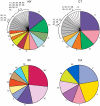Genotypic variation and mixtures of Lyme Borrelia in Ixodes ticks from North America and Europe
- PMID: 20498837
- PMCID: PMC2871049
- DOI: 10.1371/journal.pone.0010650
Genotypic variation and mixtures of Lyme Borrelia in Ixodes ticks from North America and Europe
Abstract
Background: Lyme disease, caused by various species of Borrelia, is transmitted by Ixodes ticks in North America and Europe. Studies have shown the genotype of Borrelia burgdorferi sensu stricto (s.s.) or the species of B. burgdorferi sensu lato (s.l.) affects the ability of the bacteria to cause local or disseminated infection in humans.
Methodology/principal findings: We used a multilocus PCR electrospray mass spectrometry assay to determine the species and genotype Borrelia from ticks collected in New York, Connecticut, Indiana, Southern Germany, and California and characterized isolates from parts of the United States and Europe. These analyses identified 53 distinct genotypes of B. burgdorferi sensu stricto with higher resolution than ospC typing. Genotypes of other members of the B. burgdorferi sensu lato complex were also identified and genotyped including B. afzelii, B. garinii, B. lusitaniae, B. spielmanii, and B. valaisiana. While each site in North America had genotypes unique to that location, we found genotypes shared between individual regions and two genotypes found across the United States. Significant B. burgdorferi s.s. genotypic diversity was observed between North America and Europe: only 6.6% of US genotypes (3 of 45) were found in Europe and 27% of the European genotypes (3 of 11) were observed in the US. Interestingly, 39% of adult Ixodes scapularis ticks from North America were infected with more than one genotype of B. burgdorferi s.s. and 22.2% of Ixodes ricinus ticks from Germany were infected with more than one genotype of B. burgdorferi s.l.
Conclusions/significance: The presence of multiple Borrelia genotypes in ticks increases the probability that a person will be infected with more than one genotype of B. burgdorferi, potentially increasing the risks of disseminated Lyme disease. Our study indicates that the genotypic diversity of Borrelia in ticks in both North America and Europe is higher then previously reported and can have potential clinical consequences.
Conflict of interest statement
Figures



References
-
- Falco RC, McKenna DF, Daniels TJ, Nadelman RB, Nowakowski J, et al. Temporal relation between Ixodes scapularis abundance and risk for Lyme disease associated with erythema migrans. Am J Epidemiol. 1999;149:771–776. - PubMed
-
- Hulinska D, Votypka J, Kriz B, Holinkova N, Novakova J, et al. Phenotypic and genotypic analysis of Borrelia spp. isolated from Ixodes ricinus ticks by using electrophoretic chips and real-time polymerase chain reaction. Folia Microbiol (Praha) 2007;52:315–324. - PubMed
Publication types
MeSH terms
Substances
Grants and funding
LinkOut - more resources
Full Text Sources
Other Literature Sources
Medical

